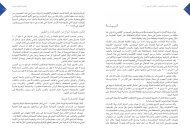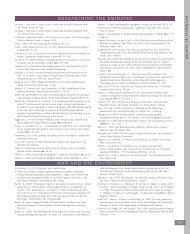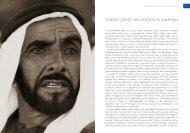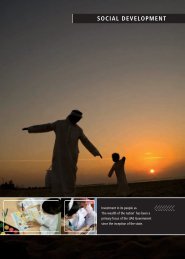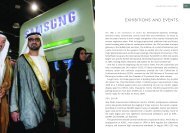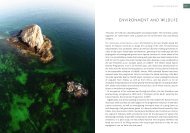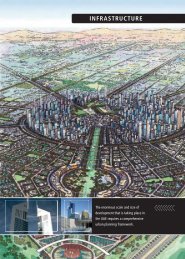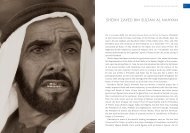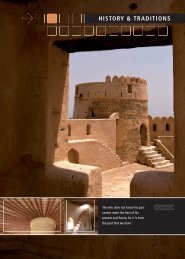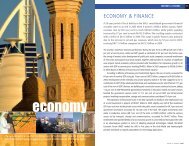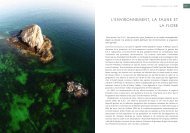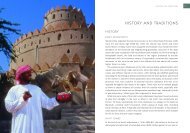Create successful ePaper yourself
Turn your PDF publications into a flip-book with our unique Google optimized e-Paper software.
132UNITED ARAB EMIRATES YEARBOOK 2006<strong>ECONOMIC</strong> <strong>DEVELOPMENT</strong>133over recent years, a programme of field development (entailing the drilling of infillwells, horizontal production wells and water injectors) has raised its reserveproductionratio and 2004 was the first time in recent years that production wasactually up on the previous year’s figures. DPC has installed water and gas injectionfacilities on a large scale to maximise recovery rates, and all the associated gasproduced at its four fields is now re-injected into oil reservoirs. Condensate isalso produced from the wholly government-owned onshore Margham field. Thecalculation on how long Dubai can keep its oil wells flowing depends on which setof figures one adopts for recoverable reserves. According to the French ComitéProfessionnel du Pétrole, Dubai produced 340,000 b/d in 2003 and 350,000 b/din 2004. This analysis indicates that it has a reserve-production ratio of 31.3 years.While oil revenues have played an important part in Dubai’s development,the emirate has followed a vigorous strategy of reducing its dependence onhydrocarbons. The sector accounted for 6.7 per cent of GDP in 2004 comparedto 24 per cent ten years previously or 50 per cent 20 years ago, in 1985. Dubai’sgovernment expects the figure to reach less than 1 per cent by 2010.SharjahSharjah’s oil reserves are put at 1.5 billion barrels of crude oil and condensate.The three onshore gas and condensate fields account for the bulk of the emirate’shydrocarbon reserves, since the Mubarak field contains less than 50 million barrelsof oil and 1500 billion cubic feet of associated gas.The emirate’s hydrocarbon production has been in decline since the mid-1990s.Following a similar trend to that in Dubai, production in 2004 was actually upon the 2003 figure. Crude and condensate combined production was 48,000 b/din 2004 compared to 46,500 in 2003. Liquids production in 2004 was made upof about 6000 b/d of crude and 12,000 b/d of condensate from the offshoreMubarak field and 30,000 b/d of condensate from the onshore Saja’a field.Sharjah passes on 20 per cent of its revenues from Mubarak to Umm al-Qaiwainand 10 per cent to Ajman.and also holds exploration licences in the emirates of Sharjah, Ajman and Ummal-Qaiwain, has been reassessing a small offshore tract known as B structure,where a non-commercial find was made in the 1970s. Novus Petroleum, owned byan Indonesian conglomerate, was assigned exploration rights to the onshore Hagilacreage, in the northern part of Ra’s al-Khaimah, in 2002. Following completion ofa 2D seismic survey in 2003, the company has recently announced plans to drillan exploration well into a zone that is thought to contain gas-bearing structures.Umm al-QaiwainAt the present time, Umm al-Qaiwain’s sole interest in oil production remains its20 per cent share of the revenues derived from the offshore Mubarak field inSharjah, part of which lies under its territorial waters.EXPLORATION AND FIELD <strong>DEVELOPMENT</strong>Abu DhabiOil and gas exploration in Abu Dhabi is primarily carried out by companies withinthe ADNOC group. While most of this is undertaken by operating companiesADCO, ADMA-OPCO and ZADCO, ADNOC also has its own ‘sole risk’ programme.The exploration programme, which began in 1950, has already yielded hugereserves of oil, and the research emphasis has now shifted from finding newfields to a more thorough examination of existing known reserves, along withsome high-tech exploration of deep oil and gas prospects. The aim is to maximisethe output of each structure through improvements in extraction methods andexpansion programmes. It is predicted that efforts currently under way, involvingan investment of over US$10 billion, will raise the <strong>UAE</strong>’s sustainable crude outputcapacity from around 2.5 mb/d at the beginning of 2004 to 3 mb/d in 2006 and3.7 mb/d by 2010. The long awaited development programme planned for UpperZakum requires a very high level of technical expertise as a result of the lowreservoir pressure and porous rocks. Introduction of an additional technical partner,in the form of ExxonMobil, provided a boost to the project.Ra’s al-KhaimahRa’s al-Khaimah’s liquid hydrocarbon reserves have been estimated at 100 millionbarrels of crude and condensate, but its only production consists of 700 b/d ofcondensate from the Saleh field.There has been a recent surge of exploration activity in Ra’s al-Khaimah withthree companies active in this field. In 1996 the Ra’s al-Khaimah Oil and GasCompany was granted exploration licences for most of the emirate’s land andseabed (with the exception of the area around the Baih field or B structure). Itsfirst well, spudded in December 1997, went down as far as 17,850 feet butproved to be dry. Meanwhile, Atlantis Holdings, which was taken over by ChinaNational Chemicals Import and Export Corporation (Sinochem) in February 2003ADCOThe Company operates and produces oil mainly from five fields Asab, Bab, Bu Hasa,Sahil and Shah. These fields are linked to the storage and shipping facilities locatedat Jebel Dhanna, where tankers load crude oil for export to markets in various partsof the world. Oil production comes also from three other oil fields: Al Dabb’iya,Rumaitha and Shanayel.ADCO is continuing its programme of exploration to search for new reserves tooffset annual production and maintain reserve levels. Current exploration/appraisaltechniques are primarily based on the extensive use of 3D seismic surveys prior towildcat, appraisal and development drilling. These have recently included a 3Dsurvey of the Qusahwira/Mender and Zarrara/Mashhur areas for the appraisal of



